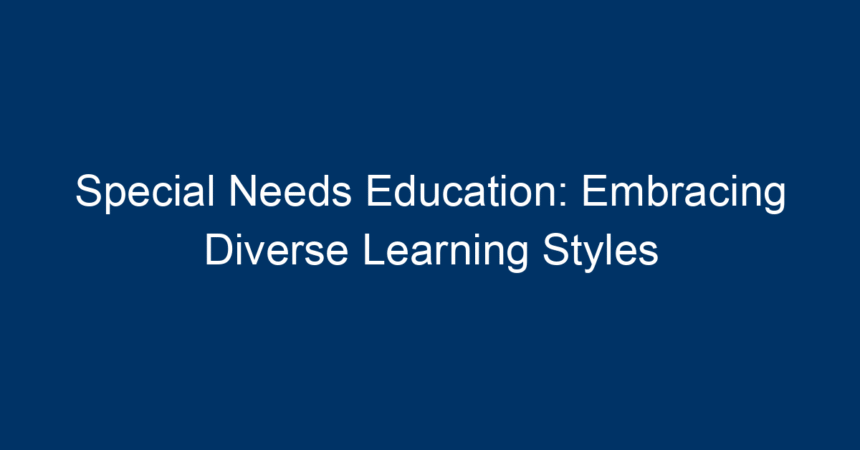In today’s inclusive society, special needs education has emerged as a beacon of hope for students with varied learning abilities. Each child possesses a unique way of grasping information—some thrive in a conventional classroom environment, while others require tailored approaches. This article delves into the importance of recognizing diverse learning styles in special needs education, offering educators, parents, and stakeholders actionable insights to enhance the learning experience for all students.
Understanding Special Needs Education
Defining Special Needs Education
Special needs education refers to tailored educational approaches designed for students with physical, emotional, behavioral, or learning challenges. The objective of this educational framework is to provide individualized support, enabling these students to reach their fullest potential in an inclusive environment.
The Importance of Inclusive Education
Inclusive education not only benefits students with special needs but also enriches the learning experience for their peers. By fostering an environment where diversity is celebrated, schools prepare all students for a compassionate and collaborative future. Understanding diverse learning styles is crucial in achieving this inclusive goal.
Recognizing Diverse Learning Styles
Visual Learners
Visual learners process information best through images and visuals. Utilizing pictures, diagrams, and videos can greatly enhance their understanding of complex concepts. In special needs education, employing tools like mind maps and infographics can stimulate engagement and retention.
Auditory Learners
Auditory learners excel when information is presented through sound. Incorporating discussions, podcasts, and audiobooks can create an interactive learning environment. Educators can facilitate group discussions or use rhymes and songs to help students grasp new material effectively.
Kinesthetic Learners
Kinesthetic learners thrive on hands-on experiences. Engaging these students in activities such as experiments, role-playing, or physical movement can significantly boost their comprehension. In special needs education, it’s essential to incorporate tactile activities that align with the curriculum.
Interpersonal and Intrapersonal Learners
While interpersonal learners connect well with others and learn best in group settings, intrapersonal learners excel when working independently. A balanced approach that provides opportunities for both social interaction and self-reflection can cater to these distinct styles.
Strategies for Implementation in Special Needs Education
Individualized Education Programs (IEPs)
IEPs are a cornerstone of special needs education, tailored to meet the specific requirements of each student. These programs should incorporate diverse learning styles to ensure inclusivity. By actively involving parents, educators, and specialists in IEP development, schools can create well-rounded educational plans.
Differentiated Instruction
Differentiated instruction is an essential component of special needs education. This approach allows educators to adjust their teaching methods based on the learning styles and capabilities of each student. By offering varied resources and alternative assessments, teachers can address diverse needs effectively.
Urbanizing the Learning Environment
Creating an accommodating learning environment plays a crucial role in special needs education. This involves modifying the classroom layout, ensuring accessibility, and providing necessary resources such as adaptive technology. A well-organized classroom fosters a sense of belonging and encourages active participation.
The Role of Technology in Special Needs Education
Assistive Technology
Assistive technology is revolutionizing special needs education. Tools such as text-to-speech software, speech recognition programs, and interactive learning apps provide additional layers of support. These technologies can bridge gaps in learning and enhance students’ engagement in the classroom.
Online Learning Platforms
The rise of online learning platforms offers flexibility for students with special needs. Asynchronous learning opportunities allow students to progress at their own pace, catering to individual learning styles. With personalized content and adaptive assessments, these platforms contribute to a more inclusive educational experience.
Building a Supportive Community
Collaboration Among Educators
The partnership between special and general education teachers is vital in fostering an inclusive environment. By collaborating, educators can share insights, strategies, and resources that address diverse learning styles. This collaboration enhances the overall learning experience and promotes a unified approach to education.
Engaging Parents and Caregivers
Parents and caregivers play an instrumental role in special needs education. Building strong communication channels between schools and families ensures that everyone involved understands the child’s unique needs. Workshops and support groups can empower parents to become advocates for their children, promoting a more cohesive educational journey.
Challenges in Special Needs Education
Limited Resources and Training
Despite the growth of special needs education, challenges remain. Many educators face constraints in resources and training, limiting their ability to cater to diverse learning styles effectively. Continuous professional development and investment in training programs can help bridge this gap.
Societal Stigmas
Unfortunately, societal stigmas surrounding disabilities can hinder the advancement of special needs education. It is essential to promote awareness and understanding within communities to combat these biases. Open dialogue regarding challenges faced by students with special needs can foster empathy and create more inclusive environments.
Actionable Insights for Educators and Parents
-
Embrace Diversity: Recognize and celebrate diverse learning styles among students. Use a variety of teaching methods to cater to different needs.
-
Invest in Professional Development: Educators should seek ongoing training in special needs education to stay updated with the latest strategies and tools.
-
Foster Connections: Build strong relationships with parents and caregivers. A collaborative approach can enhance the support system for children with special needs.
-
Utilize Technology: Adopt assistive technologies that align with the learning styles of students. Explore various online platforms to expand learning opportunities.
- Promote Awareness: Advocate for inclusive education within the community, highlighting the strengths and abilities of students with special needs.
Conclusion
Special needs education is crucial in shaping the lives of students with diverse learning styles. By embracing individuality, employing tailored strategies, and fostering supportive communities, we can create an inclusive educational landscape. As we move forward, let’s commit to understanding and addressing the unique needs of every child, ensuring that no student is left behind. Through collaboration, continued learning, and advocacy, we can empower all students to thrive academically and socially in a diverse world.




